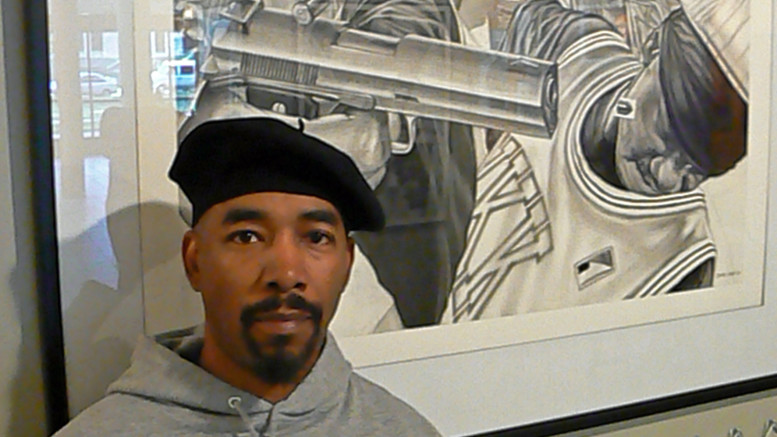DuSable Museum exhibit examines the new KKK
By La Risa Lynch
Provocative can only describe artist James Pate’s collection of charcoal drawings that visually compare Black on Black violence to that of the terrorism perpetrated by the Ku Klux Klan during the height of the Jim Crow era.
In KKK – Kin Killin’ Kin, the stark black and white images show young Black men pointing guns at each other donned in unlikely attire. The men are depicted in the “‘hood” wearing hooded pointed white hats, similar to the headgear worn by the KKK.
For Pate, the drawings represent a form of protest against Black and Black violence that has left scores dead nationwide. The exhibit runs through October 20 at DuSable Museum of African-American History, 740 E. 56th Pl.
“In a sense, I am throwing a tantrum about the situation,” said Pate, whose works have been described as a combination of realism with spatial abstraction by the Dayton City Paper. Pate refers to it as techno-cubism.
But the KKK symbolism is a metaphor for Pate, who hopes to spark discussion on Black on Black violence. The inspiration for the 12 drawings that comprise the exhibit stems from a belief in the Black community that Black on Black crime is putting the KKK out of business.
“We are doing the Klan’s business,” Pate said. “For years I’ve been hearing that so I decided I would illustrate that sentiment. I would make it literal. I would use that metaphor and push as far as my imagination would feed me…. I was really trying to turn up the volume.”
Pate turns that volume up by juxtaposing the images with historical context. In Your History II, the foreground shows two black men shooting each with discharged bullets suspended in midair. But the background is reminiscent of lunch counter sit-ins where Blacks endured abuse to integrate restaurants during the Civil Rights Movement. Pate said the images reflect Blacks’ potential and how violence undermines that potential.
“It’s an untapped resource,” he said of Black youth either dead or jailed because of violence. “Those would have been some of the brilliant minds that would have been on the engineering team, in the medical facilities, in the chemistry labs solving some of our problems.”
He too has been touched by violence. In 2011, a full ten years before he began working on the series, his nephew, Uriah, 17, was killed in gang crossfire.
“I still feel that,” said Pate, who was born in Birmingham, Al., but now lives in Dayton, Ohio. “It didn’t take Uriah for me to feel compelled enough to do these works. It is just that these are my kinfolks. We’re relatives and it gives me the blues.”
He plans to continue to expand the series as his “own private protest” until there’s a solution to gun violence. Pate started sketching the KKK series in 2000 as a way to heal wounds gun violence inflicted on the collective Black community psyche.
“It is therapeutic in a sense,” said Pate, an awarding winning self-taught artist.
The exhibit first opened in Pate’s hometown of Dayton Ohio. There he fleshed the exhibit out with discarded police tape left at crime scenes and spent bullet casings.
“This is an icon in our neighborhoods. I just collected the items just because. I didn’t know what they would be used for,” Pate said. “When the exhibited came up, it just flowed naturally right into part of the concept.”
DuSable Museum expounded on it. The museum added chain link fencing where individuals can tie toe tags in memoriam to those lost to violence. It also includes the all too familiar street memorial peppered with the usual teddy bears, balloons, candles and empty liquor bottles.
The exhibit’s curator Willis Bing Davis, who has known and followed Pate’s work for 15 years, called the exhibit powerful because of its contrasting black and white imagery. Using color would dilute the message, said Davis, founder and director of EbonNia Gallery also in Dayton,
“He uses his tremendous skills of drawing … to do it realistically as possible so you cannot miss the fact that’s a gun and that’s a bullet; so you cannot miss the fact that’s a child laying on the ground,” Davis said.
“This is not a video game,” Pate said, explaining limiting the use of color in this series. “I know that the composition itself was going to have multiple imagery; … so I didn’t want to have things so abstract that it didn’t communicate the point.”
Bradley Francois, 15, didn’t miss the point. He found the exhibit compelling.
“I think they explain a lot that’s happening in Chicago streets,” said Francois, a DuSable High School student. “Something has to be done about this because it is like an indirect genocide on all the children and teenagers in Chicago.”
DuSable is the first museum to host the exhibit thanks to museum’s president Dr. Carol Adams. Adams literally begged to get the exhibit here, which she said came at a pivotal time for Chicago. The museum is planning a series of workshops aimed at youth around the exhibit.
“This is an issue that’s being experienced in cities all over the country and something this powerful has to be used to stimulate reflection, discussion and action,” Dr. Adams said.
(This article originally appeared in ProgressIllinois.com, which ceased operations in November 2016)

Be the first to comment on "KKK-Kin Killin’ Kin: Artist James Pate’s protest against Black on Black violence"